Constance Elliot-Birks - V.A.D. Orderly/Nurse
Constance Elliott Birks was born in Sheffield, Yorkshire on 5th October 1891, the daughter of James Shipton Birks and Flora Geiger, who married at St Pancras Parish Chapel, London on the 5th March 1890. Sheffield born James, of 44 Ivydale Road, St Pancras, was 26 years of age when he married, Birmingham born, 18 year-old Flora of Nunhead, Camberwell, Surrey. James was the son of Joseph Swinden Birks and Flora was the daughter of Adolphus Frederick Geiger. Both fathers, like James, were described as "Gentlemen" in the Parish marriage record. Flora’s birth registration suggests that she was only 17 years of age at the time of her March 1890 marriage, which was by licence. Their first child, Hilda Mary, was born in Sheffield in September 1890.
Described as a "Gentleman", James’ father, Joseph Swinden Birks earned his wealth as a Grocer and Tea Merchant who, by 1881, was employing 44 men in his business in Market Place, Sheffield. In the same year, James, aged 17 years, was described as a Manufacturing Chemist and was probably working in his father’s business. Flora’s father, Adolphus, similarly described as a "Gentleman", was a commercial traveller. The varied places of birth of his six children in London, Liverpool and Birmingham testify to his movements.
By April 1891, James, Flora and 7 month old, Hilda, were boarding in Wales, where James was recorded as a wholesale grocer and probably working as a commercial traveller in his father’s tea and grocery business. Constance Elliott Birks, born in Sheffield on 5th October 1891 and baptised at St Thomas Church, Crookes, Sheffield on 3rd December 1891, was the second of three daughters and one son born to James and Flora between 1890 and 1898. The first two children, Hilda and Constance, were born in Sheffield, whilst the third child, Oswald, and fourth child, Flora, were born in London.
The children’s birthplaces suggest that the Birks family had moved from Wales to Sheffield between April 1891 and October 1892, and then to London by 1895. In 1901, James, Flora and three of their children including Constance (but excluding Hilda who was living with her grandparents elsewhere in London), were "visitors" in the Devonshire Road, Greenwich, London home of James Dardo, a Barge Builder and Chemicals Agent. James Birks had the same occupation and both men were recorded as employers.
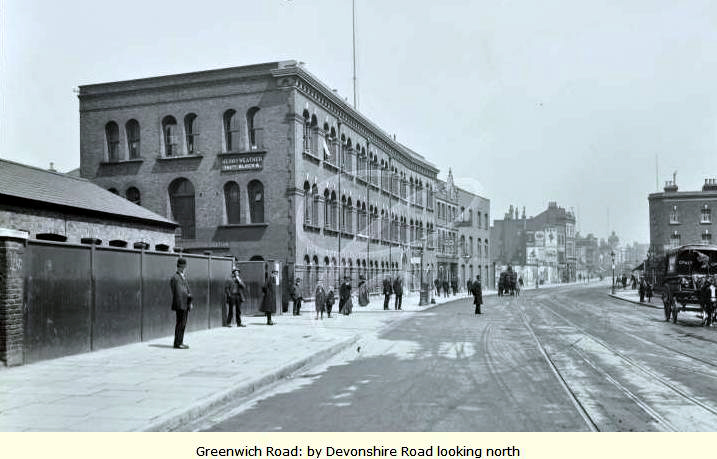
Above: Greenwich Road and Devonshire Road, London (Photograph circa 1909 Courtesy of City of London Archive)
In 1911, James Shipton Birks, one time manufacturing chemist, wholesale grocer, barge builder and chemicals agent, was now the Managing Director of a London Advertising and Press Agency. James was living in a three roomed house at 10 Faversham Road, Catford, London with his wife, Flora and their two youngest children. The 1911 whereabouts of 19 year-old Constance are unknown, but her elder sister, 20 year-old Hilda was working as a nurse at Harrogate Infirmary in that year.
Wherever Constance was in 1911, an enthusiasm for travel was in her family genes and, even as early as 1911, this wanderlust may have taken her beyond the confines of the United Kingdom. Her subsequent life, as will be seen, included much more of the same. In all senses Constance Elliott Birks was a young woman with a spirit of adventure and the intention of going places.
Indeed it may be that Constance was in Germany in 1911 since immediately prior to the outbreak of war on 4th August 1914, Constance, was studying philosophy at Munich University. Following her earlier than intended return to the UK she lived, probably with her parents, in Ruabon, near Wrexham, in North Wales. Ruabon is a village and community within the Wrexham district known for its coal mining, iron, brick, clay and chemical works. This was an industry in which Constance’s father, James, had some expertise which would be of great value to the war effort.
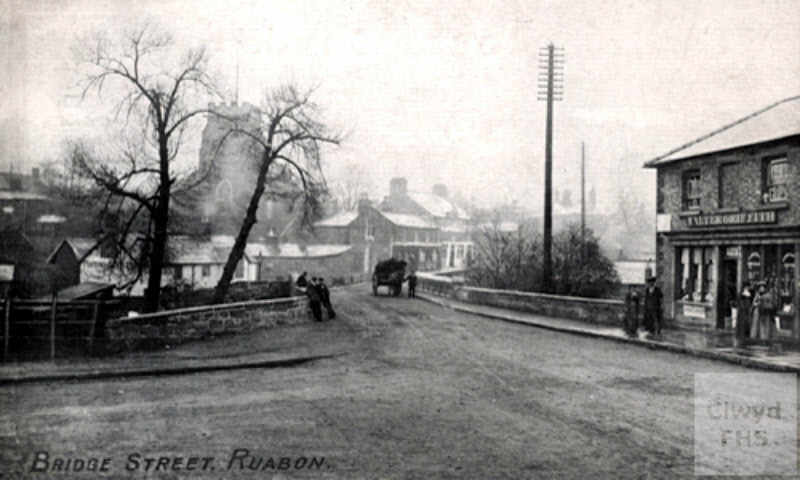
Above: Bridge Street, Ruabon, North Wales, pre 1920 (Photograph Courtesy Clwyd FHS)
By mid-March 1918 Constance had moved from North Wales to live at Sowood House, The Green, Ossett and records show that her next of kin, her father, James Shipton Birks had the same address. Before her move to Ossett, Constance was busy making her own contribution to the challenges of WW1. She began serving in 1915 as a nurse in the UK before moving overseas. She undertook some welfare supervision work among Belgian refugees in Holland and, between the 12th February 1916 and the 22nd August 1917, she was working as an Orderly for the British Committee, French Red Cross in the Scottish Women’s Hospital at Royaumont, France. Records suggest that she may also have served at Villers-Cotteret and Soissons in France. A photograph of Constance has not yet been discovered, but it is known that she was 5’3” tall with fair complexion, fair hair, blue eyes and a 33 ½" chest measurement. Her slight frame would serve her well since, in later life, she had a tendency to be forgetful about her true age.
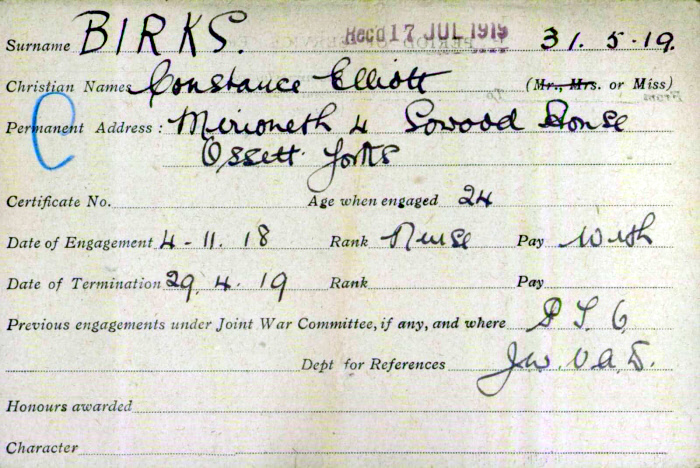
Above: VAD record card for Constance Elliott Birks.
When war broke out in August 1914 people clamoured to do what they could to support the war effort. Men volunteered for the army and others set about establishing relief units to help the army or provide assistance to civilians and refugees. The Scottish Women’s Hospitals were one of those, yet they were also very different because they were set up with two very specific aims: firstly, to help the war effort by providing medical assistance and secondly, and equally importantly, to promote the cause of women’s rights and by their involvement in the war and to help win those rights.
Their original idea had been to establish a hospital in Edinburgh to treat war wounded but this idea had been quickly abandoned in favour of establishing hospitals in the field and close to the fighting to treat the injured. The proposal received little support from the War Office but the first to accept were France and Belgium who were soon followed by Serbia.
By November 1914 the first Scottish Women’s Hospital was staffed, equipped and established at Calais to support the Belgian army. By December 1914, a second hospital was based in the ancient abbey of Royaumont, 30 km north of Paris, France. It remained operational throughout the war and treated wounded from the French army under the direction of the French Red Cross.
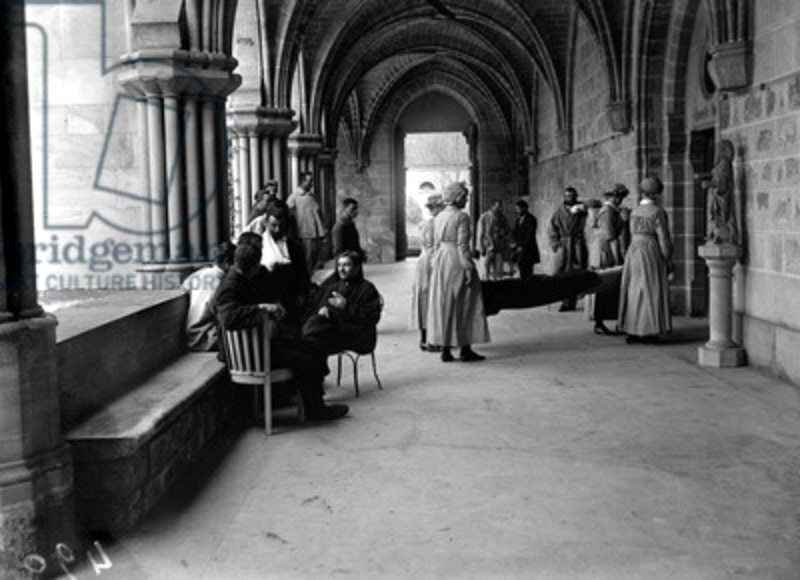
Above: Nurses carrying a wounded soldier on a stretcher at the Scottish Women's Hospital, Royaumont Abbey during WW1.
Hannah Mary Frances Ivens was Liverpool's first woman consultant and medecin chef (Chief Doctor) of the Scottish Women's Hospital, Royaumont and Villiers-Cotterets, France 1914-1919. By 1914, she was asked to run the newly formed Scottish Women's Hospital at the Abbey of Royaumont for the French Red Cross; this voluntary hospital was known as l'Hopital Auxiliare 301 d'Armee Francaise.
Regarded as the "show" hospital of the French army and staffed by women, it started with 6 patients, quickly growing to 300. In all, by the end of the war Ivens and her staff had treated over 10,800 patients. Miss Ivens opened a satellite hutted hospital close to the front at Villiers-Cotterets, which she ran until being forced to retreat back to Royaumont. She became an expert in Gas Gangrene having articles published in 1916 and 1917. Decorated with both the Croix de Guerre and the Legion d'Honneur she returned to civilian practice in Liverpool after the war.
For 18 months between February 1916 and August 1917, the Scottish Women’s Hospital at Royaumont France was the centre of Constance Elliott Birks’ life. Her efforts were acknowledged by the subsequent award to her of the British and Victory War Medals to recognise her WW1 service overseas in a theatre of war. These medals were the same as those awarded to British and Allied Forces who fought in theatres of war in 1914-1918. Constance was also recognised by the French for "serving in France nursing Belgians under Belgian doctors" when she was awarded the Médaille des épidémies et Palms d' Honneure. In summer 1917, Constance was to return to the UK following her 18 months service in France. It was her final connection with the Scottish Hospitals, but not with its founder, Hannah Mary Frances Ivens.
Constance returned from France to North Wales in August 1917 and later, in November 1917, she served as a V.A.D. Nurse in the Caerynwch Auxiliary Military Hospital, Dolgelley. At the outbreak of the First World War, the British Red Cross and the Order of St John of Jerusalem combined to form the Joint War Committee. They pooled their resources under the protection of the Red Cross emblem. As the Red Cross had secured buildings, equipment and staff, the organisation was able to set up temporary hospitals as soon as wounded men began to arrive from abroad.
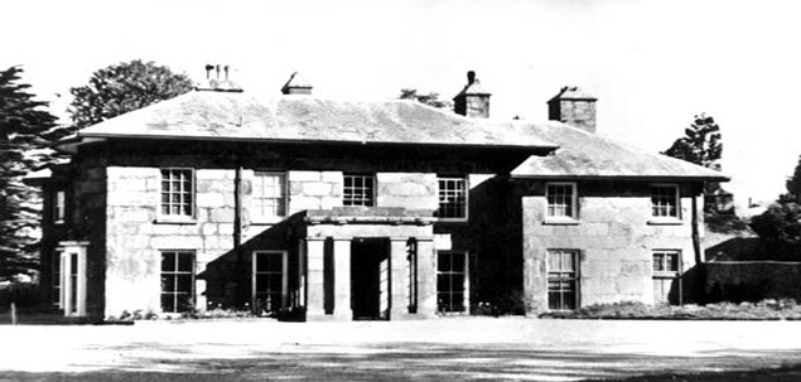
Above: Caerynwch, Dollgellau, North Wales www.caerynwch.com
The buildings varied widely, ranging from town halls and schools to large and small private houses, both in the country and in cities. The most suitable ones were established as auxiliary hospitals. These were attached to central Military Hospitals, which looked after patients who remained under military control. There were over 3,000 auxiliary hospitals administered by Red Cross county directors.
In many cases, women in the local neighbourhood volunteered on a part-time basis. The hospitals often needed to supplement voluntary work with paid roles, such as cooks. Local medics also volunteered, despite the extra strain that the medical profession was already under at that time. The patients at these hospitals were generally less seriously wounded than at other hospitals and they needed to convalesce. The servicemen preferred the auxiliary hospitals to military hospitals because they were not so strict, they were less crowded and the surroundings were more homely.
In mid January 1918 Constance began to express an interest in joining the Women’s Royal Naval Service as an Officer and two months later on 14th March 1918 she submitted an Application Form for Admission As Officer to The Women’s Royal Naval Service (W.R.N.S). Constance gave her address as Ruabon, North Wales "till 17th [March]" and as Sowood House, Ossett, Yorkshire "after 17th March". She named her father as her next of kin with the same Ossett address. She stated her date of birth as the 5th October 1892, which was one year later than her true birth date. It is possible that her parents had advanced her birth date by a year to disguise the fact that her mother was pregnant with Constance’s elder sister, at the time of their marriage. Her application was witnessed by her friend, Jacqueline T. Trotter, who was to be an important influence in this part of Constance’s life. Both young women appear to have simultaneously applied to the W.R.N.S. in March 1918.
Constance was interviewed by the W.R.N.S. Officers’ Selection Board on the 14th March 1918 and the notes of the interview began and ended with references to Constance’ friend, Miss Trotter indicating something of what was to follow. The notes reveal that "she was a friend of Miss Kathleen(sic) Trotter" and that "she wanted to go with Miss Trotter, but the Chairman told her there was not likely to be any station where we could send two Junior Officers together: possibly they might get into the same district". Unbeknown to the Selection Board, this knowledge seems likely to have been the beginning of the end of Constance’s short encounter with the Women’s Royal Naval Service.
Nonetheless the Selection Board were "very favourably impressed" by Constance and she was passed for training "at once", subject to a Medical and References. By a W.R.N.S. letter dated the 14th March 1918, Constance was summoned to hold herself in readiness to take a course of training beginning on the 18th March 1918. The letter was addressed to Constance at 18, Eaton Place, London S.W.1. This was Miss Trotter’s home address and it appears that Constance was staying with the Trotter family until early April 1918 when she returned to her Sowood House home in Ossett.
Constance was required to name two persons who could testify to her moral character. One of the references was supplied by Canon Cooper-Marsdin of Bickley, Kent who had known her for twelve years and the other was provided by Dr Frances Ivens M.D., Officer in Charge, S.W.H. Hos. Aux. 301, Royaumont. Dr Ivens’ testimony, dated the 18th March 1918, referred to Constance as “a thoroughly loyal high principled & satisfactory girl”. Constance successfully underwent a medical examination, was declared fit and was enrolled in the W.R.N.S. on 18th March 1918, the day after she moved to live at Sowood House, Ossett.
Constance began the training, but on 27th March 1918, she expressed concerns to the Selection Board regarding her suitability for the position: she felt that "she is not the right person for it" and "thought she would be hemmed in by the clerical work and the forms". On the 3rd April 1918, the W.R.N.S. Selection Board minuted "awaiting decision as to whether she [Constance Elliott Birks] intends to resign. This will probably depend on Trotter’s decision." By this time the W.R.N.S. referred to Miss Trotter, as "Trotter."
Constance withdrew from training on 6th April 1918 and her enrolment in the W.R.N.S. was cancelled. The question is whether she jumped or whether she was pushed. A W.R.N.S. file note dated 6th April 1918 reads "Miss Thomson reported that Miss Trotter and Miss Birks had been dining out with Mr. Baddeley at an hotel near the Crystal Palace and had been making fun of Captain Jones in loud enough tones to be overheard. Their remarks were repeated to Mrs Jones and Captain Jones was deeply hurt. The Naval Officers at the Depot took a serious view of the offence as it was criticism of a superior officer in public."
Writing from Sowood House, near Ossett, on the 10th April 1918, Constance wrote an extremely apologetic letter to the W.R.N.S. indicating "how very sorry I am to have to withdraw..... but the work is bigger than I expected." This may have been Constance making the point that it was she who had withdrawn from the W.R.N.S., but It is unlikely that her letter arrived before the W.R.N.S. wrote to her, at Sowood House, Ossett, in a letter dated the 11th April 1918. The W.R.N.S. were at pains to show the official record as indicating that Miss Constance Elliott Birks did not withdraw but rather that she was not suitable material. The letter read:
"Dear Madam,
I regret to inform you that the Selection Board have carefully considered the results of your training, and have decided that your qualifications do not fit you for the posts which are available in the W.R.N.S.
We regret we are unable to avail ourselves of your services."
This marked the end of Constance’s brief association with the Royal Women’s Naval Service. It appears that her friend, Trotter, had more than a bit part in the episode. So who was Trotter?
Jacqueline Theodora Trotter, was born in 1894, the elder daughter of Sir Henry Trotter KCMG (soldier, Geographer & Diplomat) and Olivia Georgiana Wellesley. Olivia was the only child of Admiral Sir George Greville Wellesley, the nephew of the Duke of Wellington and consequently Trotter’s mother, Olivia, was Wellington’s great niece. By 1911 Olivia and Sir Henry and his family were living at 18, Eaton Place, London SW1 and Constance was staying with them. For an upwardly mobile, adventure seeking new woman like Constance Elliott Birks, Trotter, was the sort of woman who could help to unlock doors.
On the 2nd April 1925, the now hyphenated Constance Elliot–Birks of 8, Carlton Hill, London N.W.8 (the home of her friend, Miss Vera Sabine Compton-Burnett) boarded the Red Star Line ship "Pittsburgh" at Southampton to sail to New York where it arrived on the 12th April 1925. It seems that Constance was in transit to Honolulu and expecting to remain there for 4/5 months. The ship’s manifest also records Constance’s declared age as 27 years, whereas she was actually 33 years old. This was not to be the first or the last time that Constance had trouble remembering her age. The only constant in the dates she gave for her age was that her birthday was the 5th October.
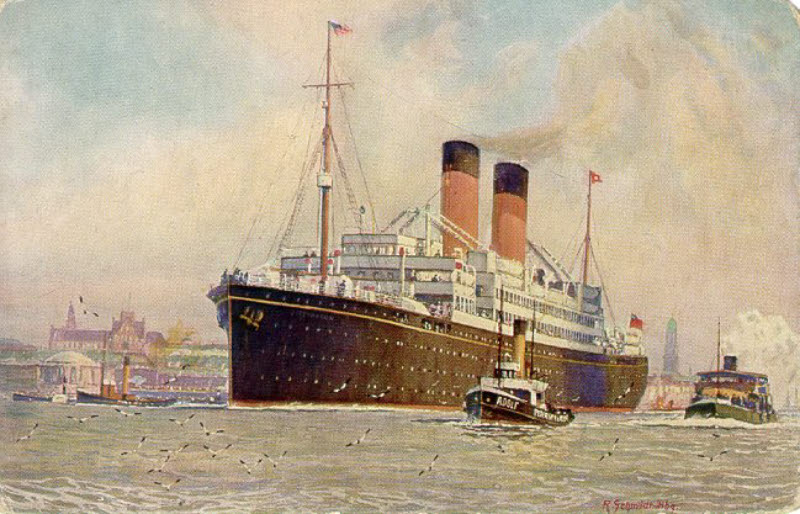
Above: SS Pittsburgh
Whilst in the U.S.A., Constance had the opportunity to demonstrate her love of dance and expression in the form of Eurythmy. This is an expressive movement art originated by Rudolf Steiner in conjunction with Marie von Sivers in the early 20th century. Primarily a performance art, it is also used in education and as part of anthroposophic medicine for claimed therapeutic purposes. On the 20th November 1925, The News Palladium from Benton harbour, Michigan carried the following story:
"Eurythmy a new art of movement, was charmingly illustrated last evening by Miss Constance Elliott-Birks o£ England. The program was given before a large audience in the St. Joseph high school auditorium, with Miss Elliott-Birks demonstrating and explaining this newest of the arts, which she described as "visible speech and sound." Every vowel and every consonant sound, was interpreted with a corresponding posture, with sound as the basic principle. Miss Elliott-Birks, is head of a school in England where eurythmy has become so enormously successful that a theatre is being built in London to house it. She was sent to Hawaii last summer where it was found that eurythmy was of tremendous value in teaching English in the schools. Last evening's program was ...... with Miss Elliott-Birks, who is a graduate of Dr. Rudolph Steiner's school in Dörnach, ¡n Switzerland."
Eurythmy also provides the link between Constance and her friend, Vera Sabine Compton-Burnett, with whom Constance was living in London before her April 1925 journey to the U.S.A. A biography, The Progonian Family Memoirs records the following:
"My days in London became even more filled with study sessions taught by Mary Kanfman (as their name was at the time), and my Eurythmy lessons. My music teacher was Constance Elliott-Birks, a very brilliant eurythymist, but she soon left to go to America, where, after a year or two, she very suddenly died. Vera and Judy Compton Burnett took over – Vera for speech and Judy for music. The Compton Burnetts were both wonderful teachers."
The reports of Constance’s death were greatly exaggerated and she returned to the U.K., via New York, aboard the White Star (Cunard) Dominion Line ship, "Alaunia", which arrived at Liverpool on 6th December 1925.
18 months later, on 25th June 1927, Constance Elliot-Birks, according to the ship manifest, aged 22 years, but really 35 years of age, sailed aboard the ship "Tuscania" for New York where it arrived on the 4th July 1927, Independence Day. Her home address was stated to be Ashford and her "nearest relative in the UK" was her father who was stated to be "Sir Jas Elliot-Birks" of Stokehouse, Ashford. More correctly her father’s name was James Shipton Birks and the name Elliott (properly spelled with two “ts”) was the surname of Constance’s maternal great grandmother. Thus her father did not have the name Elliot(t). Neither, as far as can be determined, had he been granted a knighthood.
Constance’s ultimate destination was not recorded on the ship manifest but it seems likely that she was once again heading for Honolulu where some sources suggest that she married Holbrook March Goodale. He was born in 1898 and was, therefore, seven years younger than Constance. He had a previous marriage from which he had two children, thus making Constance a stepmother. The marriage must have been short lived since Constance only arrived in New York on the 4th July 1927 and, sadly, Holbrook March Goodale died, aged 28, on 16th October 1927, some eleven days after Constance’s 36th birthday.
Holbrook was a graduate of the United States Naval Academy, class of 1921, and following his first marriage he resigned from the navy and became engaged in the sugar cane and pineapple industry. He also developed an interest in flying and sadly he lost his life in Honolulu when an airplane in which he, another man and two women "were taking panorama views burst into flames and burned the aviators to a cinder before it reached the ground"
(The Anaconda Standard, Saturday 29th October 1927.)
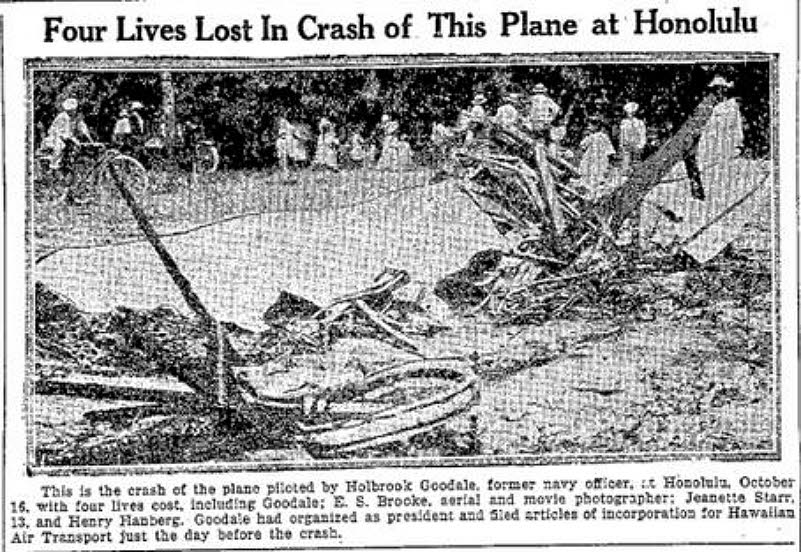
Above: Ogden Standard Examiner 31st October 1927
No record has emerged of the marriage of Constance and Holbrook Goodale, but in the following year, 1928, Constance Goodale (nee Elliott Birks) returned to the U.K., via New York, on the Cunard Liner, "Aquitania", arriving in Southampton on the 12th December 1928. She headed for her father’s home at Stoke House, Ashford Kent. She claimed to be 24 years-old, but was actually 37 years of age. She probably spent Christmas 1928 with her friends and family and on the 9th January 1929 she sailed from Southampton to New York aboard the White Star Line liner, "Majestic." Her home address was given as Porch House, Eastling and her destination was given as Honolulu.
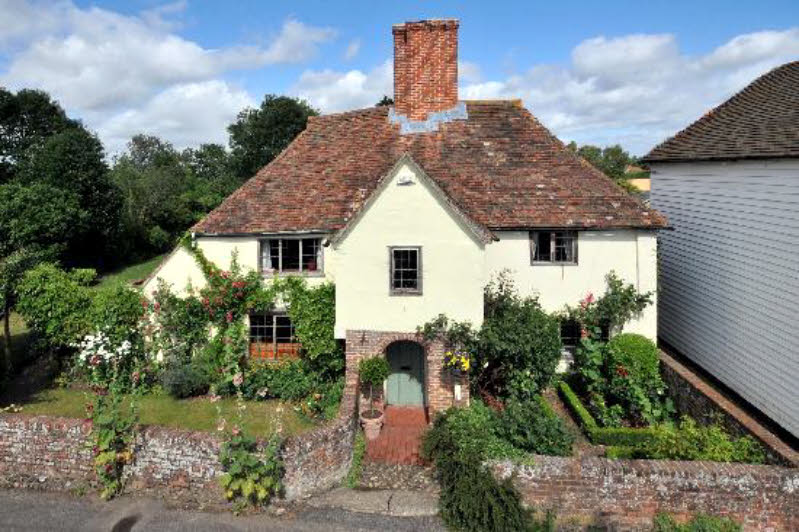
Above: Porch House, Eastling, Faversham, Kent
Ten months later, on the 1st October 1929, Constance returned to Southampton aboard the Cunard Line ship, "Mauretania", and once again she made her way to her father’s home at Stoke House, Ashford. In all earlier sea passages, her occupation or calling was entered on the manifest as "none" but in this passage the entry indicates "housewife." Constance claimed to be 24 years of age, but at the time of sailing she was four days short of her 38th birthday.
Shortly after her arrival in the UK in October 1929, Constance married stockbroker Henry John Alexander Dunsmure in Kensington, London. Henry was born in Columbo, Ceylon in 1902 and he and Constance travelled to New York in July 1933, and then to Montreal, Canada in July 1938 and again in June 1939. On the first occasion, their address was given as 20 Pelham Crescent, Kensington, London SW7. Henry was then 31 years old and Constance gave her age as 28 years (but her true age was 41 years). The couple moved later to 3 Ovington Gardens, Knightsbridge, London.
When Henry was unable to travel, Constance travelled alone. She sailed again for New York in October 1931 (arriving in New York on her birthday), September 1937, March 1954 and May 1960. On these two latter journeys her home address was 4 Herbert Crescent, Knightsbridge, London and on the 1960 voyage, she claimed to be 55 years of age, but was actually 68 years old. She also sailed to Halifax, Nova Scotia on the 28th April 1945 (two days before Hitler committed suicide and ten days before V.E. Day) On this occasion, she was accompanied by James and Alistair Dunsmure, aged 9 and 6 years respectively and her home address was given as Faitham House, Lyndhurst, Hants.
Perhaps more significantly, Constance’s occupation was stated on the ship’s manifest as "Nurse Aid", suggesting that she may have worked in this capacity during WW2. In all of the crossings, Constance records her date of birth as about 1905.
Constance Dunsmure (formerly Goodale, nee Elliott Birks) died in Buckinghamshire in September 1980 and the death registration records her as 71 years of age with a date of birth as 5th October 1908. She was actually born on 5th October 1891 and her death came a matter of weeks before her 89th birthday. Her second husband, Henry John Alexander Dunsmure, died in Buckinghamshire five months later in March 1981, aged 79 years.
Constance Elliott Birks lived a long and quite remarkable life. She lived in Ossett only fleetingly for a short period from 1918, but this was at a particularly important stage of her life. She deserves to be remembered as a woman who volunteered for service at a particularly difficult time for her Country when she need not have answered that call, but she did. She also deserves to be remembered, perhaps as much, for being one of those women who lived her life to the full at a time when women were beginning to assert their right to live their lives as they wished and not as they were told.